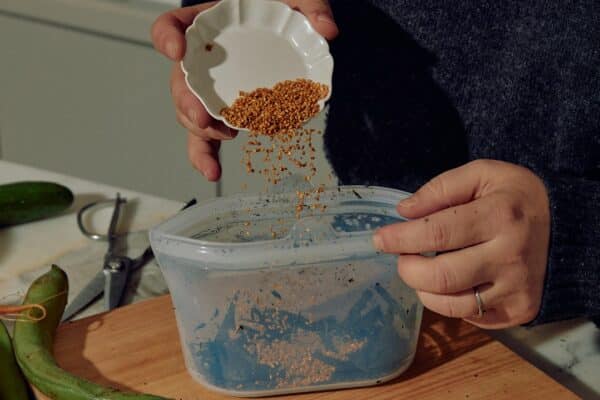‘Black Friday, Buy 1 Get 2 Free, Boxing Day Sales, Christmas, Birthdays, Discount codes, Celebrity Endorsements…’ consumerism is never-ending. We have been programmed as a society to be consumers, surrounded by advertising in every aspect of our lives and it’s literally killing us.
The fact is we are all guilty of consuming more than we need, we get bored easily, and everything is accessible. We are all guilty sometimes of aimlessly scrolling through Instagram, subconsciously being sold clothing none of us need.
Image Via A Pair And A Spare DIY

‘(Consumerism)… is also one of the central influences exacerbating key global problems such as the environment (including climate change and the unsustainable use of natural resources) and social justice (including poverty and human rights abuses).’ – The problem with consumerism, Life Squared
There’s one key way to combat buying more stuff, learn how to fix or update the old. You don’t necessarily need to whip up a handbag from an old pair of jeans, but it’s a fun way of creating ‘new’ stuff that’s unique. Even just learning how to sew on a button is the first step to fighting the consumer loophole of buying new stuff.
Here’s a wonderful list full of inspiration and information, with lots of explainer videos.
Sewing by hand
Sewing seems like it’s tough, when in fact the basics are useful and not too complicated. Firstly, invest in a basic sewing kit, starter ones start at around $5.99 from Spotlight. There are lots of helpful videos and articles available online for all your basic sewing needs, but let’s start with the most obvious ones.
Sewing a button
Sewing a button is the most simple and surprisingly satisfying task to learn. It takes a few minutes. WikiHow does a perfect job explaining the steps here. You can also use this to replace buttons on a shirt or dress to make it look different!
Sewing a rip
If a rip is small for example a tear on a shirt or seam, it can be quite simple to fix. Select a thread from your kit that’s matching and the right needle (thick or sharp) and again follow these great instructions from WikiHow here.
Embroidery
Cute stitching on clothing can completely transform a plain white tee or denim jacket, from small lettering to giant flowers.
Here’s a great how-to video to start with:
Next steps would be purchasing a sewing machine or taking a class!
Patches
If you like the look of embroidery but can’t face hand stitching, patches are a great alternative. They are also perfect for covering up holes, stains that won’t budge or just jazzing up plain clothing. There are multiple stores that sell different types of patches, from iron-on to regular. There are lots of patches available from Etsy here. For iron-on patches, you simply need to iron the patch in the desired place with a cloth over the top (such as a pillowcase).
Repurposing
Jeans into shorts
Cutting jeans into shorts is an easy way of turning old clothing into something new. The important thing is to do it correctly; otherwise, you may end up with wonky shorts (I speak from experience)
Cropped shirt
Cutting a shirt or t-shirt shorter can transform a dull item and takes around five minutes with a pair of scissors. Pair with high-waisted trousers!
Hair ties
Hair ties are perfect on all occasions, especially to cover unwashed hair. Source soft silk fabric or scarfs from an op shop and wear in your hair multiple ways. Scarfs can also be added to plain bags to jazz them up, wrapping them around the handle.
Adjustments
Jeans
Jeans are a staple wardrobe item but are now sold for hundreds of dollars just for extra rips. Making adjustments to jeans is super easy and can change a dull pair into entirely new ones. Chloe Wen shows how it’s done perfectly in the video below, using kitchen scissors and a cheese grater.
Plant dyeing
If you’re feeling brave, follow our easy guide on dyeing your clothing with natural plant-based dye here. It works best with silk, wool, linen or cotton.


